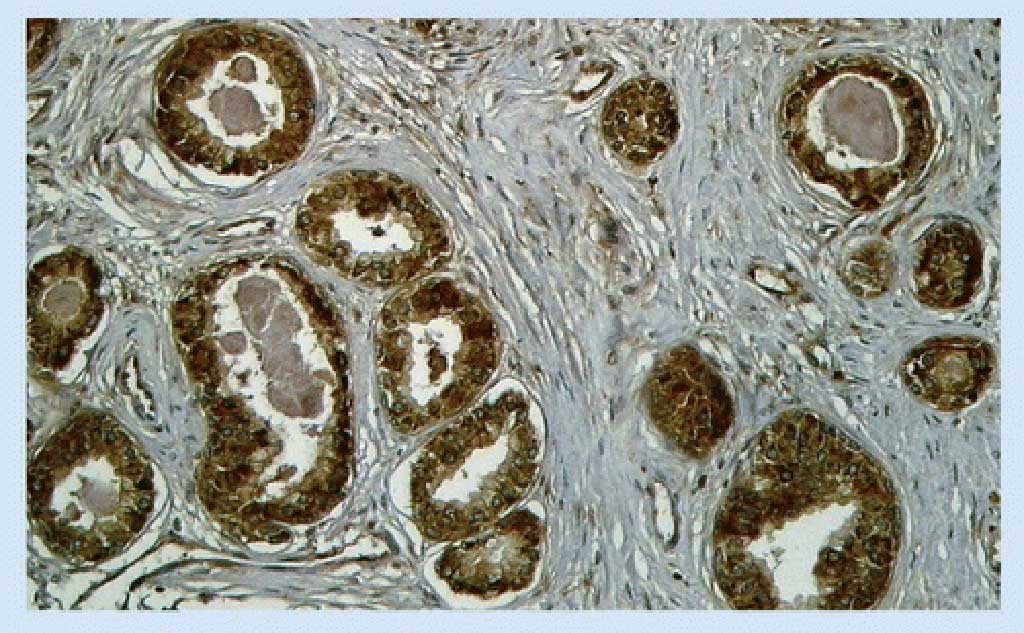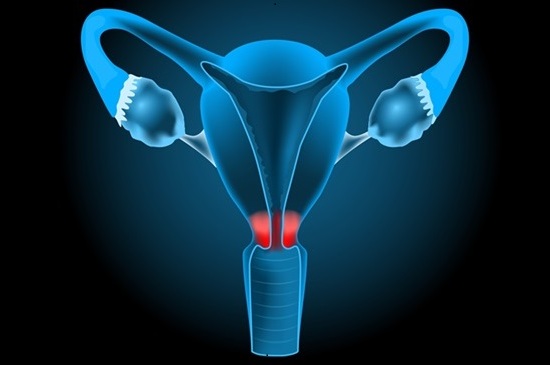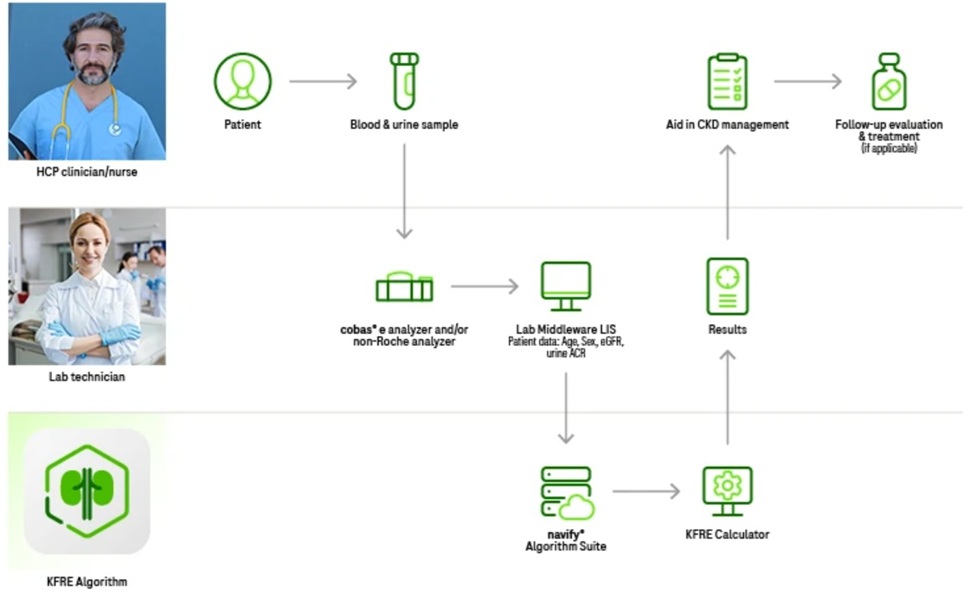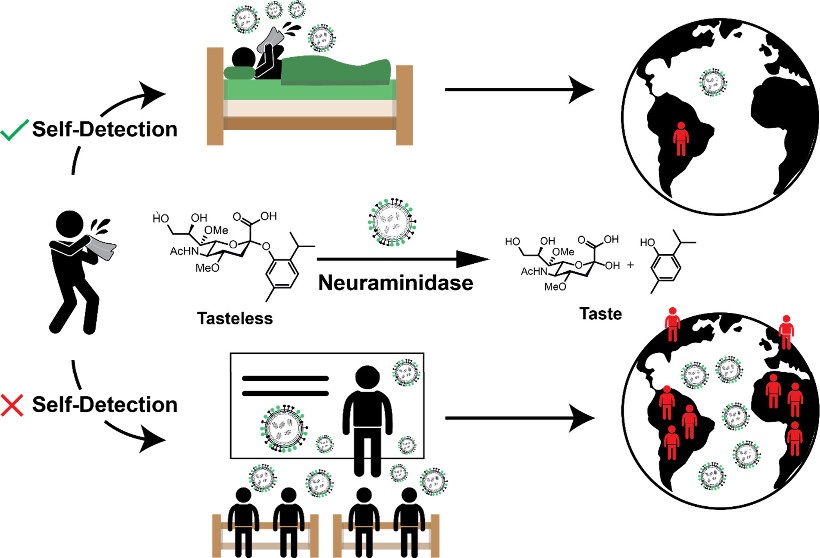Protein Biomarker Increases Sensitivity of a Urine-based Prostate Cancer Test
|
By LabMedica International staff writers Posted on 05 May 2021 |

Image: EN2: a novel prostate cancer biomarker (Photo courtesy of Future Medicine)
A team of British researchers increased the sensitivity of an advanced RNA and DNA biomarker-based urine test for diagnosis of aggressive prostate cancer by including the measurement of a protein biomarker, which is expected to reduce the number of unnecessary biopsies performed every year by up to 35%.
Prostate cancer exhibits extreme clinical heterogeneity; 10‐year survival rates following diagnosis approach 84%, yet prostate cancer is still responsible for 13% of all cancer deaths in men in the United Kingdom. Current practice assesses a patient's disease using a PSA (prostate specific antigen) blood test, prostate biopsy, and MRI. However, up to 60% of men with a raised PSA level are negative for prostate cancer on biopsy.
Coupled with the high rates of diagnosis, prostate cancer is more often a disease that men die with rather than from. This illustrates the urgent need for clinical tools able to selectively identify those men with cancers that only require monitoring from those men harboring a disease that requires intervention.
Recently, investigators at the University of East Anglia (Norwich, United Kingdom) developed a multivariable risk prediction model called ExoMeth by integrating clinical, urine‐derived cell‐free messenger RNA (cf‐RNA) and urine cell DNA methylation data capable of noninvasively detecting significant prostate cancer in patients in lieu of biopsy.
In the current study, the investigators extended this approach by developing a urine test that not only predicted whether a patient had prostate cancer but also indicated how aggressive the disease was. This model (ExoGrail) combined the measurement of the protein-marker Engrailed-2 (EN2) and the levels of 10 genes measured in urine.
EN2 is a homeodomain-containing transcription factor that has an essential function in early development, which in mammals includes the delineation of the midbrain/hindbrain border. For a transcription factor it has a number of unusual properties, including the ability to be secreted from cells and taken up by others. Indeed, a recent study indicated that prostate cancer cells can secrete EN2 protein through vesicles which are then taken up by other non-EN2 expressing cells, where it can directly influence the transcription of target genes. The secretory behavior of EN2 makes it a potential biomarker for prostate cancer, and indeed EN2 protein can be detected in the urine of men with prostate tumors. The original and subsequent studies have generally supported a diagnostic role for urinary EN2, including a relationship between urinary EN2 concentration and tumor volume. More recently, a lateral flow-based test for EN2 has been described that could potentially allow point-of-care testing.
During the current study, the investigators used the new ExoGrail test to analyze urine samples from 207 patients who had undergone prostate cancer biopsy. Results revealed that the test identified which patients had prostate cancer and which did not. Furthermore, the ExoGrail test provided risk scores for patients and highlighted those for which an invasive biopsy would have been beneficial.
Senior author Dr. Dan Brewer, senior lecturer in cancer studies at the University of East Anglia, said, "While prostate cancer is responsible for a large proportion of all male cancer deaths, it is more commonly a disease men die with rather than from.
Therefore, there is a desperate need for improvements in diagnosing and predicting outcomes for prostate cancer patients to minimize over-diagnosis and over treatment whilst appropriately treating men with aggressive disease, especially if this can be done without taking an invasive biopsy. Invasive biopsies come at considerable economic, psychological, and societal cost to patients and healthcare systems alike. Our new urine test not only shows whether a patient has prostate cancer, but it importantly shows how aggressive the disease is. This allows patients and doctors to select the correct treatment. And it has the potential to reduce the number of unnecessary biopsies by 35%."
The ExoGrail urine test for detection of prostate cancer was described in the April 27, 2021, online edition of the journal Cancers.
Related Links:
University of East Anglia
Prostate cancer exhibits extreme clinical heterogeneity; 10‐year survival rates following diagnosis approach 84%, yet prostate cancer is still responsible for 13% of all cancer deaths in men in the United Kingdom. Current practice assesses a patient's disease using a PSA (prostate specific antigen) blood test, prostate biopsy, and MRI. However, up to 60% of men with a raised PSA level are negative for prostate cancer on biopsy.
Coupled with the high rates of diagnosis, prostate cancer is more often a disease that men die with rather than from. This illustrates the urgent need for clinical tools able to selectively identify those men with cancers that only require monitoring from those men harboring a disease that requires intervention.
Recently, investigators at the University of East Anglia (Norwich, United Kingdom) developed a multivariable risk prediction model called ExoMeth by integrating clinical, urine‐derived cell‐free messenger RNA (cf‐RNA) and urine cell DNA methylation data capable of noninvasively detecting significant prostate cancer in patients in lieu of biopsy.
In the current study, the investigators extended this approach by developing a urine test that not only predicted whether a patient had prostate cancer but also indicated how aggressive the disease was. This model (ExoGrail) combined the measurement of the protein-marker Engrailed-2 (EN2) and the levels of 10 genes measured in urine.
EN2 is a homeodomain-containing transcription factor that has an essential function in early development, which in mammals includes the delineation of the midbrain/hindbrain border. For a transcription factor it has a number of unusual properties, including the ability to be secreted from cells and taken up by others. Indeed, a recent study indicated that prostate cancer cells can secrete EN2 protein through vesicles which are then taken up by other non-EN2 expressing cells, where it can directly influence the transcription of target genes. The secretory behavior of EN2 makes it a potential biomarker for prostate cancer, and indeed EN2 protein can be detected in the urine of men with prostate tumors. The original and subsequent studies have generally supported a diagnostic role for urinary EN2, including a relationship between urinary EN2 concentration and tumor volume. More recently, a lateral flow-based test for EN2 has been described that could potentially allow point-of-care testing.
During the current study, the investigators used the new ExoGrail test to analyze urine samples from 207 patients who had undergone prostate cancer biopsy. Results revealed that the test identified which patients had prostate cancer and which did not. Furthermore, the ExoGrail test provided risk scores for patients and highlighted those for which an invasive biopsy would have been beneficial.
Senior author Dr. Dan Brewer, senior lecturer in cancer studies at the University of East Anglia, said, "While prostate cancer is responsible for a large proportion of all male cancer deaths, it is more commonly a disease men die with rather than from.
Therefore, there is a desperate need for improvements in diagnosing and predicting outcomes for prostate cancer patients to minimize over-diagnosis and over treatment whilst appropriately treating men with aggressive disease, especially if this can be done without taking an invasive biopsy. Invasive biopsies come at considerable economic, psychological, and societal cost to patients and healthcare systems alike. Our new urine test not only shows whether a patient has prostate cancer, but it importantly shows how aggressive the disease is. This allows patients and doctors to select the correct treatment. And it has the potential to reduce the number of unnecessary biopsies by 35%."
The ExoGrail urine test for detection of prostate cancer was described in the April 27, 2021, online edition of the journal Cancers.
Related Links:
University of East Anglia
Latest Molecular Diagnostics News
- Urine Test Could Replace Painful Kidney Biopsies for Lupus Patients
- Blood Test Guides Post-Surgical Immunotherapy for Muscle-Invasive Bladder Cancer
- Mitochondrial DNA Mutations from Kidney Stressors Could Predict Future Organ Decline
- Blood Test Could Predict Bariatric Surgery Outcomes in Teenagers
- ctDNA Blood Test to Help Personalize Postsurgical Colon Cancer Treatment
- AI Powered Blood Test Predicts Suicide Risk in Bipolar Patients
- DNA Sensor Enables Molecular Detection from Single Blood Drop
- DNA-Powered Test Accurately Detects E. Coli Lookalike Bacteria
- World’s Fastest DNA Sequencing Technique to Revolutionize NICU Genomic Care
- Blood Test Uses Cell-Free DNA to Detect ALS Faster and More Accurately
- Multi-Cancer Early Detection Blood Test Increases Cancer Detection
- Portable Label-Free Device Tracks Alzheimer's Disease in Real Time
- Liquid Biopsy Test Enables Early Detection of ICI-Related Myocarditis
- Rapid POC Diagnostic Test Detects Asymptomatic Malaria Cases
- Improved DNA Sequencing Tool Uncovers Hidden Mutations Driving Cancer
- Newborn Genomic Screening Enables More Lifesaving Diagnoses
Channels
Clinical Chemistry
view channel
VOCs Show Promise for Early Multi-Cancer Detection
Early cancer detection is critical to improving survival rates, but most current screening methods focus on individual cancer types and often involve invasive procedures. This makes it difficult to identify... Read more
Portable Raman Spectroscopy Offers Cost-Effective Kidney Disease Diagnosis at POC
Kidney disease is typically diagnosed through blood or urine tests, often when patients present with symptoms such as blood in urine, shortness of breath, or weight loss. While these tests are common,... Read moreHematology
view channel
Viscoelastic Testing Could Improve Treatment of Maternal Hemorrhage
Postpartum hemorrhage, severe bleeding after childbirth, remains one of the leading causes of maternal mortality worldwide, yet many of these deaths are preventable. Standard care can be hindered by delays... Read more
Pioneering Model Measures Radiation Exposure in Blood for Precise Cancer Treatments
Scientists have long focused on protecting organs near tumors during radiotherapy, but blood — a vital, circulating tissue — has largely been excluded from dose calculations. Each blood cell passing through... Read more
Platelets Could Improve Early and Minimally Invasive Detection of Cancer
Platelets are widely recognized for their role in blood clotting and scab formation, but they also play a crucial role in immune defense by detecting pathogens and recruiting immune cells.... Read more
Portable and Disposable Device Obtains Platelet-Rich Plasma Without Complex Equipment
Platelet-rich plasma (PRP) plays a crucial role in regenerative medicine due to its ability to accelerate healing and repair tissue. However, obtaining PRP traditionally requires expensive centrifugation... Read moreImmunology
view channel
Molecular Microscope Diagnostic System Assesses Lung Transplant Rejection
Lung transplant recipients face a significant risk of rejection and often require routine biopsies to monitor graft health, yet assessing the same biopsy sample can be highly inconsistent among pathologists.... Read more
Blood Test Tracks Treatment Resistance in High-Grade Serous Ovarian Cancer
High-grade serous ovarian cancer (HGSOC) is often diagnosed at an advanced stage because it spreads microscopically throughout the abdomen, and although initial surgery and chemotherapy can work, most... Read more
Luminescent Probe Measures Immune Cell Activity in Real Time
The human immune system plays a vital role in defending against disease, but its activity must be precisely monitored to ensure effective treatment in cancer therapy, autoimmune disorders, and organ transplants.... Read more
Blood-Based Immune Cell Signatures Could Guide Treatment Decisions for Critically Ill Patients
When a patient enters the emergency department in critical condition, clinicians must rapidly decide whether the patient has an infection, whether it is bacterial or viral, and whether immediate treatment... Read moreMicrobiology
view channel
Fast Noninvasive Bedside Test Uses Sugar Fingerprint to Detect Fungal Infections
Candida bloodstream infections are a growing global health threat, causing an estimated 6 million cases and 3.8 million deaths annually. Hospitals are particularly vulnerable, as weakened patients after... Read more
Rapid Sepsis Diagnostic Device to Enable Personalized Critical Care for ICU Patients
Sepsis is a life-threatening condition that occurs when the body’s response to infection spirals out of control, damaging organs and leading to critical illness. Patients often arrive at intensive care... Read morePathology
view channel
AI-Powered Method Combines Blood Data to Accurately Measure Biological Age
Chronological age tells us how many years we’ve lived, but not how quickly our bodies are ageing. Some people stay healthy well into their 80s or 90s, while others experience decline much earlier.... Read more
AI Tool Detects Cancer in Blood Samples In 10 Minutes
Detecting cancer recurrence or spread often depends on identifying rare tumor cells circulating in the bloodstream — a process known as a liquid biopsy. However, current methods rely on trained specialists... Read moreTechnology
view channel
Viral Biosensor Test Simultaneously Detects Hepatitis and HIV
Globally, over 300 million people live with Hepatitis B and C, and 40 million with HIV, according to WHO estimates. Diagnosing bloodborne viruses such as HIV and Hepatitis B and C remains challenging in... Read more
Acoustofluidic Device to Transform Point-Of-Care sEV-Based Diagnostics
Rapid and sensitive detection of small extracellular vesicles (sEVs)—key biomarkers in cancer and organ health monitoring—remains challenging due to the need for multiple preprocessing steps and bulky... Read moreIndustry
view channel
Advanced Instruments Merged Under Nova Biomedical Name
Advanced Instruments (Norwood, MA, USA) and Nova Biomedical (Waltham, MA, USA) are now officially doing business under a single, unified brand. This transformation is expected to deliver greater value... Read more


















